Damping Spring Hinges, a sophisticated evolution in the realm of hinge technology, have become increasingly popular for their unique ability to provide a smooth and controlled closing motion. These hinges are designed to offer a balance between functionality and user comfort, setting them apart from traditional spring hinges. In this article, we will delve into the distinctions between Damping Spring Hinges and their more conventional counterparts, examining their design, operation, and applications.

The primary function of any hinge is to allow the rotation or pivoting of a door or cover. Traditional spring hinges, while effective, often lack the finesse of Damping Spring Hinges. The latter incorporates a damping mechanism that slows down the closing speed of the door, reducing noise and wear. This feature is particularly beneficial in environments where noise control is paramount, such as in hospitals, libraries, or residential settings.
One of the noticeable differences between Damping Spring Hinges and traditional spring hinges is the inclusion of a damping component. This component, often a gas or oil-filled chamber, works to absorb the kinetic energy of the closing door, thereby reducing the impact at the point of closure. Traditional spring hinges, on the other hand, rely solely on the spring's tension to close the door, which can cause a sudden and potentially loud impact.
The design of Damping Spring Hinges also tends to be more complex than that of traditional spring hinges. They often feature additional components such as dampers and seals, which contribute to their enhanced performance. These added elements not only improve the user experience by providing a soft close but also extend the life of the hinge by reducing the stress on the hinge's components.
In terms of operation, Damping Spring Hinges offer a more refined movement. They are engineered to control the speed at which a door closes, ensuring a gentle and quiet operation. Traditional spring hinges, in contrast, may result in a door slamming shut, which can be jarring and less controlled.
When it comes to applications, Damping Spring Hinges are often preferred for their ability to provide a high level of user comfort and safety. They are commonly used in cabinetry, furniture, and architectural projects where a soft-close feature is desired. Traditional spring hinges, while still widely used, may not offer the same level of control and are more likely to be found in applications where a soft-close feature is not a priority.
The performance of Damping Spring Hinges in various environmental conditions is also good to that of traditional spring hinges. They are designed to maintain their damping properties even in extreme temperatures and humidity levels, ensuring consistent performance. Traditional spring hinges may experience changes in their spring tension under such conditions, causing unpredictable door closure.
Maintenance and durability are other areas where Damping Spring Hinges excel. The inclusion of seals and the damping mechanism helps to protect the internal components from dust, moisture, and other contaminants, which can degrade the performance of traditional spring hinges over time.
In conclusion, Damping Spring Hinges offer a range of advantages over traditional spring hinges, including controlled closing, reduced noise, and enhanced durability. Their sophisticated design and operation make them the preferred choice in many applications where a soft-close feature is desired. As the demand for quieter and more controlled door closures grows, it is likely that the use of Damping Spring Hinges will continue to expand, further distinguishing them from traditional spring hinges.